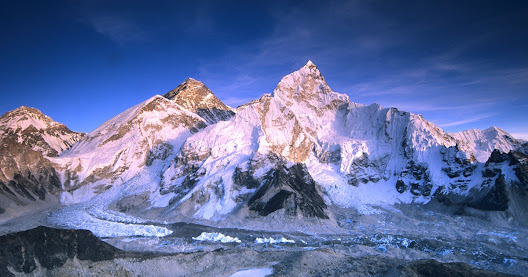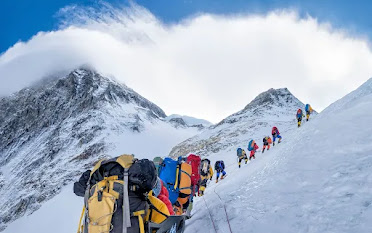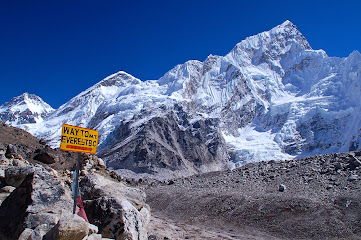Mount Everest, also known as Sagarmatha in Nepali and Chomolungma in Tibetan, is the highest mountain in the world. It is located in the Himalayas on the border between Nepal and Tibet (China). Here are some key details about Mount Everest:
1. Height: Mount Everest stands at an elevation of 8,848.86 meters (29,031.7 feet) above sea level, making it the tallest peak on Earth.
2. First Ascent: The first successful ascent of Mount Everest was accomplished by Sir Edmund Hillary of New Zealand and Tenzing Norgay, a Sherpa of Nepal, on May 29, 1953. Their expedition was led by Sir John Hunt.
3. Routes: There are several routes to reach the summit of Mount Everest, but the two most popular ones are the South Col route from Nepal and the North Col route from Tibet. The South Col route via the Southeast Ridge is the more frequently used path.
4. Challenges: Climbing Mount Everest is a formidable and dangerous undertaking due to extreme altitude, unpredictable weather, high winds, low oxygen levels, and difficult terrain. Many climbers have lost their lives while attempting to summit the mountain.
5. Sherpas: The indigenous Sherpa people of Nepal are renowned for their mountaineering skills and have played a crucial role in supporting Everest expeditions. They serve as guides, porters, and climbers, assisting climbers with equipment, establishing camps, and ensuring their safety.
6. Commercial Expeditions: Over the years, climbing Mount Everest has become a popular adventure tourism activity. Numerous commercial expeditions are organized by experienced mountaineering companies that provide logistical support to climbers, including Sherpa guides, equipment, and permits.
7. Environmental Concerns: Mount Everest faces environmental challenges, such as overcrowding, waste management, and the impact of climate change. Efforts are being made to regulate climbing permits, clean up the mountain, and raise awareness about responsible mountaineering.
8 Location: Mount Everest is situated in the Mahalangur Range of the Himalayas, specifically in the Khumbu region of Nepal and the Tingri County of Tibet (China). The mountain's precise coordinates are approximately 27.9881° N latitude and 86.9253° E longitude.
9. Formation and Geology: Mount Everest is part of the Himalayan mountain range, which was formed by the collision of the Indian and Eurasian tectonic plates. The mountain is primarily composed of sedimentary and metamorphic rocks, including limestone, shale, and schist. It features distinct layers of rock, tilted at an angle due to tectonic forces.
9. Three Main Peaks: Mount Everest has three main peaks: the South Summit, the Central Summit (the highest point), and the North Summit. The South Summit is slightly lower than the Central Summit and serves as the last obstacle before reaching the true summit.
10. Height Variations: Over the years, the official height of Mount Everest has varied due to different measurement methods and advancements in technology. The current accepted height, 8,848.86 meters (29,031.7 feet), was determined by the Survey of India in 2020 using global navigation satellite systems and gravity data.
11. Climbing Season: The primary climbing season for Mount Everest is during the spring (April-May) and autumn (September-October). These periods offer relatively stable weather conditions and a higher chance of success in reaching the summit. However, some climbers also attempt ascents during other times of the year.
12. Mountaineering Routes:
- South Col Route (Southeast Ridge): This is the most popular and frequently used route to the summit. It begins in Nepal's Khumbu Valley and involves passing through famous landmarks like Base Camp, the Khumbu Icefall, the Western Cwm, the Lhotse Face, the South Col, and the Hillary Step.
- North Col Route (Northeast Ridge): This route starts from Tibet's Rongbuk Glacier and passes through the North Col, the Northeast Ridge, the Three Steps, and the Hillary Step. It is considered more challenging than the South Col Route.
13. Climbing Difficulty: Mount Everest is considered one of the most challenging mountains to climb due to its extreme altitude and harsh weather conditions. Climbers face significant risks, including altitude sickness, avalanches, crevasses, storms, and frostbite. Proper acclimatization, physical fitness, and mountaineering experience are crucial for a safe and successful ascent.
14. Records and Achievements:
- Youngest Climber: In 2010, Jordan Romero from the United States became the youngest person to reach the summit of Mount Everest at the age of 13.
- Fastest Ascent: In 2019, Kami Rita Sherpa set a record by reaching the summit for the 24th time, the most ascents by any individual.
- Without Supplemental Oxygen: Several climbers have successfully reached the summit without the use of supplemental oxygen, including Reinhold Messner and Peter Habeler in 1978, and more recently, Kilian Jornet in 2017.
Remember that climbing Mount Everest is an extremely challenging and risky endeavor, requiring proper training, experience, and preparation. It's essential to respect the mountain and prioritize safety when attempting to summit.
Reaching the summit of Mount Everest is an extraordinary feat that requires extensive preparation, physical fitness, mountaineering experience, and careful planning. Here are the general steps involved in climbing Mount Everest:
1. Physical Conditioning: Mountaineering at extreme altitudes demands excellent physical fitness. Engage in a long-term training program that includes cardiovascular exercises, strength training, endurance activities, and high-altitude acclimatization.
2. Research and Planning: Gather as much information as possible about the mountain, its routes, weather patterns, permits, and logistics. Research reputable mountaineering companies or expeditions that organize trips to Everest and provide necessary support and guidance.
3. Choose a Route and Team: Decide on the route you want to take based on your experience and goals. The South Col Route from Nepal is the most popular choice. Find a reliable expedition team with experienced guides, Sherpa support, and a proven safety record.
4. Obtain Permits: Acquire the necessary permits and permissions from the respective government authorities. In Nepal, you'll need a climbing permit issued by the Department of Tourism, and in Tibet (China), you'll require permission from the Chinese Mountaineering Association.
5. Training and Acclimatization: Participate in pre-expedition training and acclimatization programs organized by your chosen expedition team. These programs usually take place in the Everest region, allowing you to adapt to higher altitudes and practice climbing techniques.
6. Base Camp: Begin the expedition by trekking to Everest Base Camp (5,364 meters/17,598 feet) in Nepal or the equivalent in Tibet. Set up a base camp to serve as a staging area for further acclimatization and preparation.
7. Camps and Climbing: Establish a series of camps at various altitudes, typically Camp 1 (6,065 meters/19,900 feet), Camp 2 (6,500 meters/21,325 feet), Camp 3 (7,200 meters/23,620 feet), and Camp 4 (7,950 meters/26,085 feet). Ascend and descend the mountain in stages, allowing your body to adjust to the increasing altitude and reduced oxygen levels.
8. Summit Push: Plan a strategic summit push based on favorable weather conditions and your physical readiness. Typically, climbers aim to reach the summit from Camp 4, passing through the South Col, the Balcony, the Hillary Step, and the final ridge to the summit. Summit attempts are often made during early morning hours to maximize safety and reduce exposure to changing weather conditions.
9. Safety and Decision-making: Always prioritize safety during the climb. Listen to your guides, pay attention to your body's signals, and be prepared to turn back if conditions become hazardous or if you experience altitude sickness or other health issues.
10. Summit Success and Descent: If you successfully reach the summit, take a moment to appreciate the accomplishment. However, remember that reaching the summit is only halfway done. Descending safely is equally crucial, as the majority of accidents and fatalities occur during the descent.
It's important to note that climbing Mount Everest is an extremely challenging and dangerous endeavor, and it should not be taken lightly. Consider seeking professional guidance, joining an organized expedition, and ensuring you have adequate experience and skills before attempting to summit the mountain.








